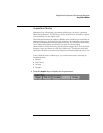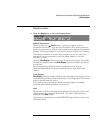
4-23
MegaZoom Concepts and Oscilloscope Operation
Pan and Zoom
Pan and Zoom
The ability to pan (move horizontally) and zoom (expand or compress
horizontally) an acquired waveform is important because of the additional
insight it can reveal about the captured waveform. This additional insight is
often gained from seeing the waveform at different levels of abstraction. You
may want to view both the big picture and the specific little picture details.
The ability to examine waveform detail after the waveform has been acquired
is a benefit generally associated with digital oscilloscopes. Often this is simply
the ability to freeze the display for the purpose of measuring with cursors or
printing the screen. Some digital oscilloscopes go one step further by including
the ability to further examine the signal details after acquiring them by panning
and zooming through the waveform.
There is no limit imposed on the zoom ratio between the sweep speed used to
acquire the data and the sweep speed used to view the data. There is, however,
a useful limit. This useful limit is somewhat a function of the signal you are
analyzing.
In normal display mode, with vectors (connect-the-dots) off, you can zoom in
to the point where there are no samples on the screen. Obviously, this is far
beyond the useful limit. Likewise, with vectors on, you can see the linear
interpolation between the points, but again, this is of very limited value.
Zoom
The screen will still contain a relatively good display if you zoom in horizontally by a
factor of 1000 and zoom in vertically by a factor of 10 to display the information from
where it was acquired. Remember that you can only make automatic measurements
on displayed data.


















